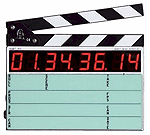 Why use 30 fps Time Code when shooting at 24 fps film? 30 fps Time Code is used when transferring film to 29.97 fps video for video/workstation editing or when transferring to mag film. The following chart shows the frames that are coincident between 30 fps and 24 fps.
Why use 30 fps Time Code when shooting at 24 fps film? 30 fps Time Code is used when transferring film to 29.97 fps video for video/workstation editing or when transferring to mag film. The following chart shows the frames that are coincident between 30 fps and 24 fps.
|
24fps
|
30fps
|
Real Time | |
| Frame # |
0
|
0
|
Start of the Second |
| Frame # |
4
|
5
|
166.6667 mS |
| Frame # |
8
|
10
|
333.3333 mS |
| Frame # |
12
|
15
|
500 ms (Half a Second) |
| Frame # |
16
|
20
|
666.6667 ms |
| Frame # |
20
|
25
|
833.3333 ms |
As seen in the chart above, every fourth frame at 24 fps matches every fifth frame at 30 fps. The film transfers at a rate of 23.976 fps when converted to video at 29.97 fps during the 3-2 pulldown. At the same time the audio is also slowed down from 30 fps to 29.970 fps. This results in an exact match in the video transfer. Recording 30 fps time code at 48 KHz means that the transfer house has to sample your tape at 47.952 KHz (using special decks) to achieve the .1% pulldown necessary for the 3-2 pulldown. If the recorder supports the 48.048 KHz sampling rate then the tape can be played back at 48KHz, which produces the same .1% pulldown using the standard available decks.
The audio can then stay in the digital domain. NTSC video frames are composed of two interlaced fields, each containing half the picture information. One field contains all the odd scan lines, the other all the even scan lines. When 24 frame film is transferred to NTSC, the first film image is placed in three successive video fields and the second frame image is placed in the next two successive video fields. This process is repeated until the end of the film. Artifacts of this process can be seen if you play the videotape in very slow motion. There are many good resources available for more information on the 3-2 pulldown process.
How does this relate to 23.976 fps and HD?
High Definition Cameras are in fact capable of running 24 fps progressive scan. This is different than NTSC, which is 29.970 interlaced. If you use 24P (P = Progressive), it must be down converted to 29.97 fps NTSC for video assist or editing on an Avid. Also, when running 24P the audio TC must run at 30 fps. Currently the down conversion from 24P is not practical. A solution is to run the HD camera at 23.976. The High Def conversion to NTSC video can then use the available standards converters. The following chart shows the frames that are coincident between 29.970 and 23.976.
|
23.976fps
|
29.970fps
|
Real Time | |
| Frame # |
0
|
0
|
Start of the Second |
| Frame # |
4
|
5
|
166.8333 mS |
| Frame # |
8
|
10
|
333.6667 mS |
| Frame # |
12
|
15
|
500.5 ms (Half a Second) |
| Frame # |
16
|
20
|
667.3333 ms |
| Frame # |
20
|
25
|
834.1667 ms |
Again, every fourth frame at 23.976 fps matches every fifth frame at 29.970 fps. What does this mean to the audio Time Code? Just run it at 29.97 fps! The same sync relation from the 3-2 pull down chart holds true. The difference being that there is not a speed change on the audio or video and the sampling rate can stay at 48KHz.
